Blog sidebar
Category
Recent Posts
- Dec 24, 2025
- Dec 21, 2025
- Dec 19, 2025
- Dec 17, 2025

The Ultimate Guide to Using Bio Oil for Keloid Treatment
Contents
Section 1: Introduction
A Compelling Opening to the Debate on Skin Restoration
Scars, especially keloids, are more than skin deep—they are a lasting physical reminder of trauma, surgery, or acne, often extending beyond the original wound with an emotional impact to match. For many, the quest to soften or reduce keloid appearance becomes both a personal and medical journey. Amid a sea of treatment options, some individuals turn to everyday skincare staples in search of relief. In this introduction, we explore whether mainstream products offer real benefits or if deeper remedies are required.
Why Keloid Management Demands Expert Attention
Unlike typical scars, keloids involve an overgrowth of dense collagen that continues beyond injury borders and rarely regresses without intervention. Medical research reflects this complexity—silicone gel sheeting is considered a first-line therapy due to its hydration and occlusion benefits, supported by clinical trials and systematic reviews highlighting its efficacy for hypertrophic and keloid scars (Wikipedia on silicone gel sheeting), and others report limited evidence for alternative treatments (Wikipedia on keloid treatment limitations).
Introducing Everyday Skincare Choices into the Conversation
On the consumer side, products like Bio‑Oil have gained popularity for fading stretch marks or smoothing regular scars. Yet their impact on stubborn keloids remains uncertain. While some users observe softened texture or reduced redness over time, experts note that surface-level moisturisers may not address the deeper collagen proliferation that defines keloids (Healthline’s review of Bio‑Oil benefits).
The rising interest in combining mainstream skincare with traditional or medical options reflects an increasingly nuanced approach to keloid management. In this article, we will guide you through evidence-based therapies, user experiences, and actionable insights to help you make informed choices—starting with a critical look at how everyday oils could fit into a broader strategy.
The Role of Bio Oil in Keloid Treatment
Bio Oil has gained attention for its potential benefits in skincare, particularly in managing scars and keloids. As part of an evolving strategy for keloid management, Bio Oil offers a complementary option that promises gentle care alongside other treatments. But what makes Bio Oil an appealing choice for those battling with keloids?
Understanding Bio Oil's Composition
Bio Oil is a formulation blended with plant extracts and vitamins suspended in an oil base. Key ingredients such as vitamin E, rosemary oil, and chamomile extract contribute to its efficacy. Vitamin E, known for its antioxidant properties, aids in improving the appearance of scars by enhancing skin hydration and elasticity. Furthermore, rosemary oil provides anti-inflammatory benefits, while chamomile soothes irritated skin. These properties make bio oil a candidate for softening the texture and reducing the discomfort of keloids.
Scientific Insights and User Experiences
Although direct studies on bio oil for keloids are limited, anecdotal evidence suggests that consistent application might improve keloid symptoms over time. In a study on the effects of Bio Oil on scar improvement, users reported positive changes in both colour and texture after regular use, according to NCBI. Beyond individual reports, dermatologists have highlighted the importance of occlusive therapy in maintaining skin moisture and flexibility, which could contribute to reducing keloid severity.
Comparative Analysis: Bio Oil vs. Other Options
Understanding where Bio Oil stands in the spectrum of keloid treatments is crucial for making informed decisions. Below is a comparison with other common options:
| Treatment | Application Frequency | Primary Benefit | Cost |
|---|---|---|---|
| Bio Oil | Daily | Hydration and softening | Moderate |
| Silicone Gel | Twice daily | Smooths skin texture | High |
| Injections (Corticosteroids) | Monthly | Reduces size and pain | High |
As seen, bio oil is a versatile and accessible option compared to more intensive treatments. Its role in keloid care is largely supportive, aiming to complement core medical interventions. Those considering bio oil should look into personalized regimens, ideally under dermatologist guidance, to effectively integrate it into their skincare routines.
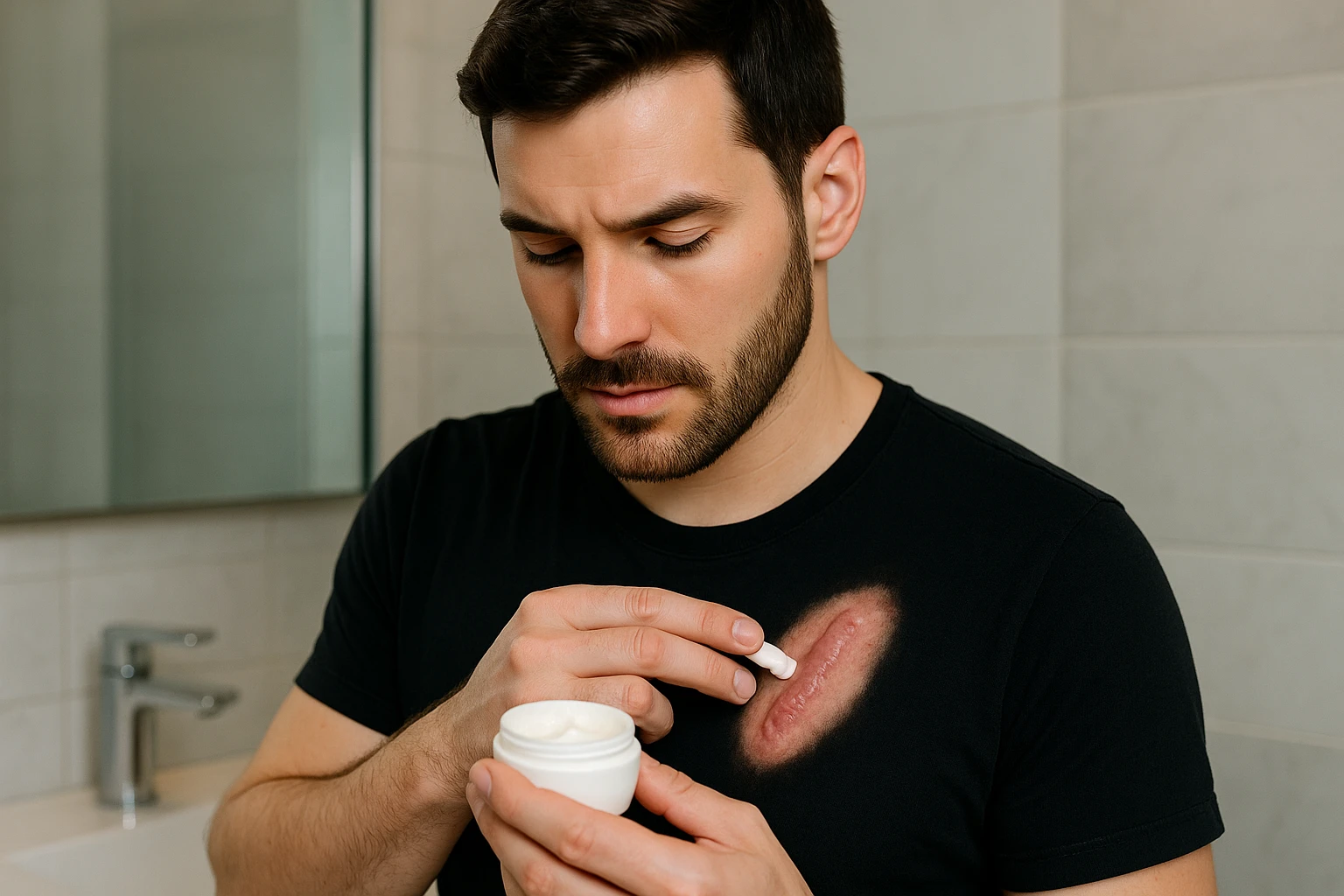
Section 3: What Research and Real-World Evidence Suggest About the Effectiveness of Bio Oil for Keloid Scars
Current Scientific Understanding
Although there is considerable interest in treating raised and keloid scars with topical oils, the scientific evidence remains limited. For instance, one controlled study demonstrated that oils rich in omega‑3 fatty acids were able to suppress keloid fibroblast proliferation in vitro, suggesting a possible mechanism for scar modulation—but this remains preliminary and far from clinical application, PubMed study.
Moreover, clinical data specifically on Bio‑Oil’s efficacy in managing keloids is scarce. According to Healthline, the formulation tends to work best on fresh or non‑keloid scars; treatment of established keloid or hypertrophic scars may require more potent interventions like silicone or professional procedures Healthline source.
Consumer Reports and Anecdotal Evidence
Despite the lack of robust clinical trials, many users share personal accounts online. Some report notable improvements with regular massage and application. One Reddit user described how daily massage of a surgical scar with Bio‑Oil led to faster visual improvement than observed in other areas Reddit user experience. Similarly, another user managing a keloid post-surgery reported softening when combining massage, Bio‑Oil, and scar creams over time another Reddit thread.
Practical Insights and Recommendations
These anecdotes emphasise two key factors: consistent, long-term use and mechanical massage. Even without definitive clinical endorsement, these elements appear to contribute to perceived improvement. In cases where the keloid is recent or the skin remains pliable, this method may offer some benefit.
Nevertheless, individuals must proceed with caution. Bio‑Oil may not deliver meaningful change in mature keloids, and sensitising ingredients - such as fragrance components - can provoke reactions in sensitive skin. For persistent or symptomatic keloids, consulting a dermatologist for options like silicone therapy, steroid injections, or laser remains prudent.
Conclusion
In summary, while high‑quality evidence supporting the use of Bio‑Oil for keloid scars is lacking, anecdotal cases and in vitro data hint at possible benefits under specific conditions - namely, early intervention, regular massage, and consistent application. That said, Bio‑Oil should not be relied upon alone; combining it with medically validated treatments offers a more realistic pathway toward managing keloid scarring.
Section 4: Comparative Mechanisms and Complementary Practices
Building upon earlier discussions, we now examine how Bio‑Oil’s properties align - or diverge—from medically validated treatments, and explore complementary strategies that may enhance outcomes when managing keloid scars.
Moisturisation versus therapeutic action
Most of Bio‑Oil’s perceived benefits stem from its moisturising and emollient properties, courtesy of mineral oil, sunflower seed oil, vitamin E, and botanical extracts such as chamomile and lavender. This blend offers a soft, supple skin feel and may help surface appearance, but lacks proven mechanisms to suppress collagen overgrowth characteristic of keloids. As noted by Healthline, Bio‑Oil showed modest reductions in scar appearance by roughly 14 %—yet this data pertains to non-keloid scars only, highlighting limitations in applicability to hypertrophic or keloid lesions, Healthline.
How silicone sheeting achieves a deeper impact
By contrast, silicone gel sheeting—regarded as a gold-standard, first-line intervention for keloids—acts through prolonged occlusion and hydration, which can help flatten raised scars and reduce redness. Its efficacy is supported by systematic reviews and clinical consensus, with proposed mechanisms including increased collagenase activity, modulation of fibroblast growth, and even electric polarisation of scar tissue Wikipedia (Silicone gel sheeting). These functional responses go beyond mere moisturisation and speak directly to modifying scar biology.
Emerging solvent-based alternatives—research insights
Innovative research has explored oils rich in omega‑3 fatty acids, such as fish oil and traditional remedies like shea butter or boa constrictor oil. In cultured studies, such oils demonstrated inhibitory effects on keloid fibroblast proliferation—suggesting potential for therapeutic influence on collagen production, though real-world, clinical validation remains pending PubMed Central.
Practical applications and integration tips
For individuals keen to include Bio‑Oil as part of a broader keloid management approach, a layered method may offer some benefit. One such routine includes:
- Starting with gentle silicone gel sheeting or silicone-based topical gels to target scar physiology
- Applying Bio‑Oil after removing silicone sheets or following gel absorption to maintain skin moisturisation
- Incorporating light massage for several minutes to assist absorption and potentially reduce local stiffness
This dual strategy leverages the proven efficacy of silicone while ensuring skin remains supple—an important consideration when treating mature scars.
Transitioning into the following sections, we will delve into combining Bio‑Oil with professional treatments, ensuring a holistic and evidence-based regimen that balances comfort, safety, and factual potential.
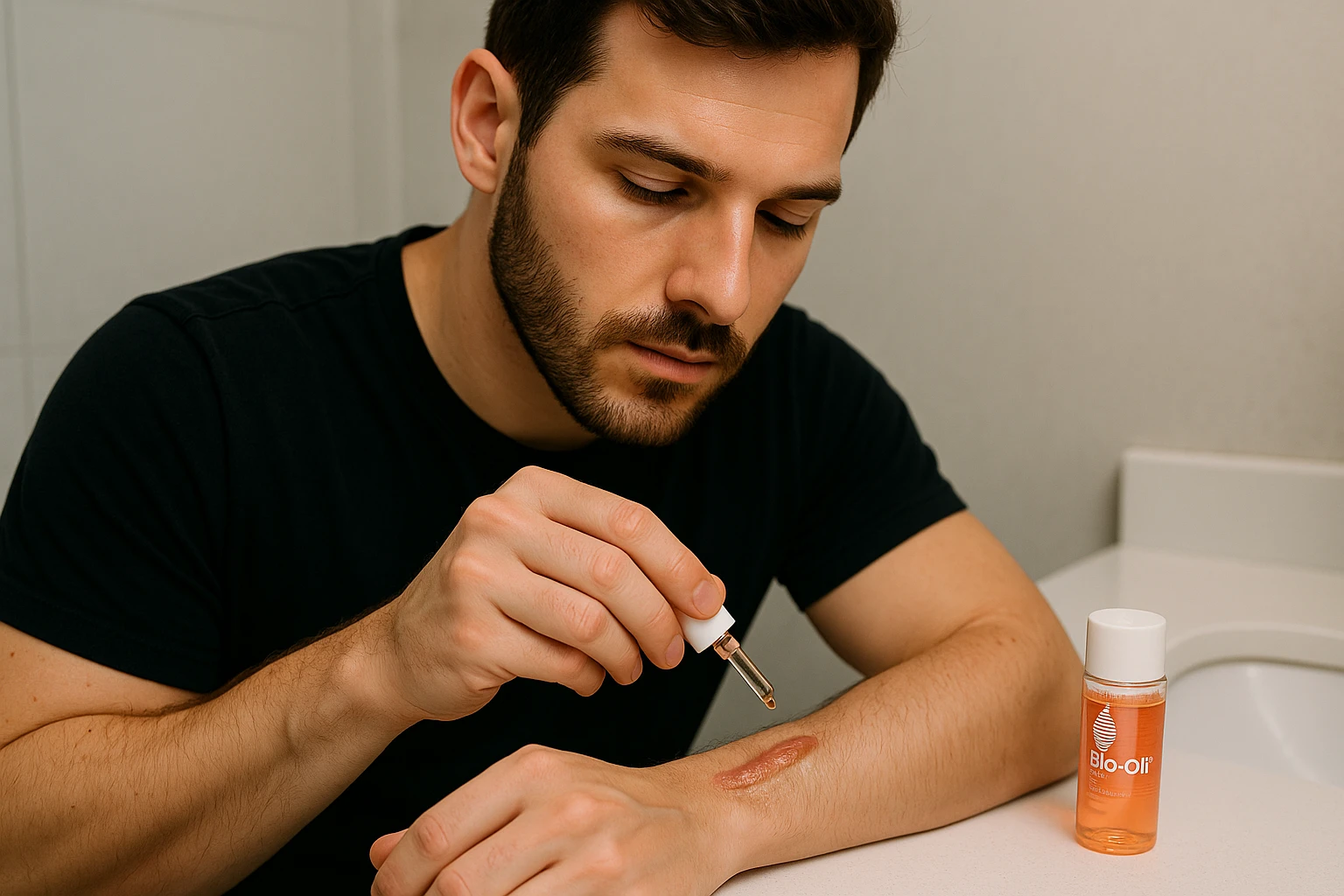
Section 5: User Experiences and Mixed Results
Continuing from the clinical background, it’s essential to explore real-world accounts of using the product, particularly when individuals consider Bio Oil for keloids. These personal insights shed light on the variability of outcomes and practical considerations.
Mixed Insights from Online Communities
Some users on platforms such as Reddit report modest improvements in keloid appearance. For instance, one user mentioned that after months of consistent use, their keloid felt softer and appeared slightly less red—improvements attributed to the oil’s moisturising and anti‑inflammatory properties keloidstreatment.com. Another user shared that Bio‑Oil helped ease the texture and colour of an old keloid, although such results seemed rare among other contributors reddit.com.
Conversely, more sceptical experiences highlight the limitations. Some users found little to no change—scars maintained their height, firmness and appearance despite prolonged application keloidstreatment.com. Others found the oil too greasy or irritating for sensitive scar tissue, leading them to discontinue use reddit.com.
Why Results May Vary
Several factors contribute to these conflicting experiences. Keloids differ significantly from other scars in their depth and collagen structure, meaning typical moisturising effects cannot reduce their volume or fibrotic build-up keloidstreatment.com. Instead, positive outcomes are most likely limited to superficial aspects—such as reduced redness and enhanced softness—particularly in newer or less pronounced scars.
Practical consistency also matters. Reports suggest that regular, twice-daily application over weeks or months can yield gradual enhancements in skin feel, though not dramatic structural changes feau.com. Users who did not maintain routine use often experienced limited or no visible effect.
Takeaways for Real-World Use
- Real individuals report both slight improvements and considerable disappointment—highlighting the subjective nature of results.
- Moisturisation and reduced redness are the most consistently noted benefits, likely offering temporary cosmetic improvements.
- Users often emphasise the importance of patience and repetition; sporadic application yields minimal benefit.
- For established, raised keloids, relying solely on Bio‑Oil may not address the underlying fibrous tissue effectively.
These user experiences underscore that while bio oil for keloids may offer some cosmetic smoothing and hydration, expectations must remain realistic. It's best seen as a complementary skincare regimen rather than a standalone medical treatment.
6. Complementary Science and Evidence-Based Context
How Bio‑Oil Fits Within Evidence-Based Scar Strategies
Continuing from the consideration that bio oil for keloids may provide cosmetic smoothing and hydration, it’s vital to situate it alongside treatments underpinned by stronger clinical support. For instance, silicone gel sheeting is widely recognised as a first-line therapy for both hypertrophic and keloid scars due to its proven efficacy in providing occlusion and hydration—mechanisms that soften scar tissue and improve texture over time Silicone gel sheeting (Wikipedia). In contrast, while Bio‑Oil offers moisturising benefits, its effects appear limited when compared to such established modalities.
Biochemical Insights from Alternative Oil Sources
Laboratory studies shed light on the potential of certain oils in affecting keloid fibroblast behaviour. Research published in the NIH’s PMC platform observed that oils rich in omega‑3 fatty acids, such as fish oil and shea butter, were more effective at inhibiting keloid fibroblast growth than corticosteroid controls in vitro PMC study on omega‑3 fatty acids. Although Bio‑Oil does not prominently feature these components, these findings suggest that selecting oils with specific fatty acid profiles could complement standard keloid management strategies.
Setting Realistic Expectations and Integration Strategies
In practical terms, patients should view Bio‑Oil as a supplementary approach rather than a substitute for clinically supported treatments. It may contribute by keeping the scarred area well-hydrated and pliable, which in itself may aid the effectiveness of other therapies. The BestProducts review quotes dermatologists emphasising that well-hydrated skin is more flexible and less prone to trauma, which can enhance scar appearance and healing when combined with techniques like massage Does Bio‑Oil Work – What Dermatologists Say. Massage in circular motions—as recommended with Bio‑Oil—can further encourage scar tissue reorganisation.
In summary, while Bio‑Oil alone is unlikely to significantly reduce established keloids, when integrated with proven therapies—such as silicone sheeting or omega‑3-enriched products—it may support a more holistic approach. This balanced strategy aligns with evidence-based dermatological care, helping patients set informed, realistic goals for scar management.
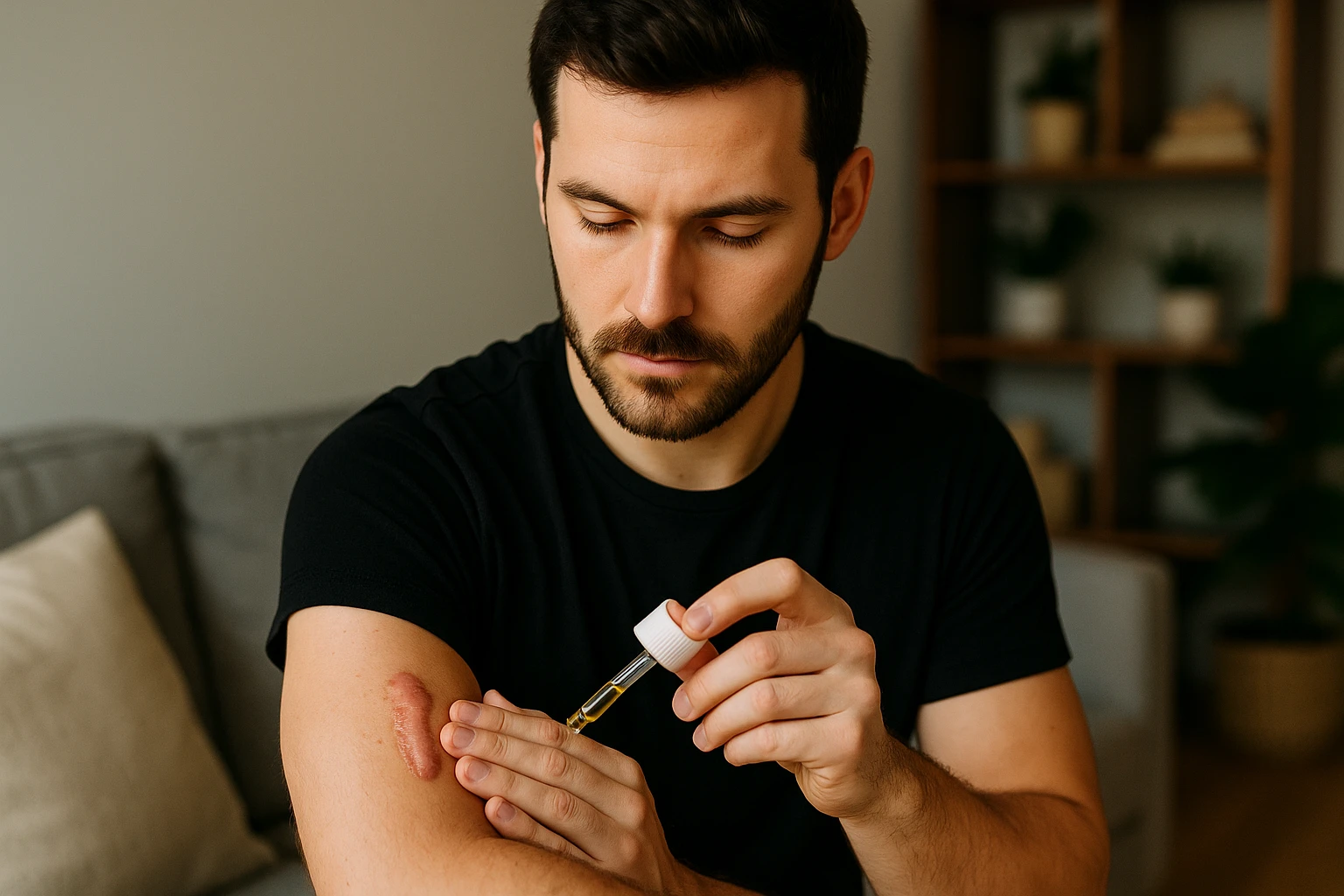
7. Limitations of Bio-Oil for Keloid Management and When to Seek More Effective Therapies
Shifting focus from general scar appearance to the specific challenge of keloid formation reveals important nuances. While products designed for moisturising and aesthetic improvement—like Bio-Oil—can assist with superficial changes, they often fail to address the underlying structural issues of keloid scars. A recent analysis emphasises that while hydration from ingredients such as vitamin E and plant oils may enhance surface texture and reduce redness, these effects are largely cosmetic and do not target deep fibrous collagen growth typical of keloids. Keloids Treatment Review.
Consequently, relying solely on bio oil for keloids may lead to unmet expectations for significant reduction. User reports echo this limitation—many note only minor smoothing or colour fading, without meaningful change in size or firmness. One user on a keloid-focused discussion stated that, despite consistent use, their keloid remained largely unchanged in shape and texture, while another continued to experience persistent itching despite application Keloids Treatment Reddit Compilation.
When to Consider Medical Interventions
Given the resilient nature of keloids, especially longstanding or thickened lesions, more robust treatments often become necessary. Options such as silicone gel sheeting are widely accepted as a first-line therapy due to their proven effectiveness in reducing scar elevation and recurrence by providing occlusion and hydration Silicone Gel Sheeting Overview. Additionally, treatments like intralesional corticosteroid injections, cryotherapy, laser therapy, or pressure therapy typically yield more substantial improvements in contour and size.
For instance, a controlled trial using silicone cream with occlusive dressing demonstrated significant improvement in keloid reduction compared to cream alone—82% of treated cases showed notable benefits versus only 22% with simpler application methods (p < 0.01) Hirshowitz et al., Br J Plast Surg., 1991. This highlights how structured delivery systems, including occlusion, drive better outcomes in addressing the collagen overgrowth central to keloids.
In clinical contexts where keloid scars persist despite conservative measures, professional evaluation is advisable. Dermatologists or plastic surgeons can recommend advanced or combined modalities tailored to individual scar characteristics, ensuring a more reliable path to functional and cosmetic improvement.
8. Integrating Bio-Oil into Your Broader Keloid Care Plan
Transitioning from professional interventions and advanced therapies, it’s useful to explore how products like Bio Oil for keloids can complement these approaches. While not a standalone solution for stubborn keloid tissue, strategic use may support skin comfort and hydration, and serve as an adjunct in a more comprehensive scar‑management routine.
Combining Products and Techniques
Many patients report benefit from layering topical moisturisers such as Bio‑Oil with evidence‑based treatments like silicone sheeting. For example, one user disclosed that they ‘massaged three times a day with bio‑oil and lotion with vitamin E’ in conjunction with silicone strips, although the keloid remained pronounced—highlighting that massage and moisturisation may ease discomfort even when scar height persists reddit.com.
Timeframe and Expectations
Consistency appears key. In a six‑month case shared on an online forum, a user recounted the gradual softening and lightening of their keloid over two years, attributing part of this improvement to regular use of moisturising agents, including Bio‑Oil reddit.com. These anecdotal insights indicate that while immediate visual improvements may be limited, long‑term persistence with topical care can support scar pliability and skin tone.
Real‑World Perspectives on Moisturiser Utility
A skincare reviewer’s evaluation found only 51% of users believed Bio‑Oil improved their scars or stretch marks, while 17% saw no effect thedermdetective.com. Their verdict recommended it primarily for hydration rather than targeted scar reduction. This aligns with broader dermatological consensus: hydration alone does not significantly influence collagen architecture, but it does aid in symptom relief.
Best Practices for Application
- Apply to fully healed skin to avoid trapping moisture and irritation.
- Use gentle massage motions to promote circulation—this may help soften the scar tissue.
- Pair with silicone strips or gels, which are first‑line options for keloid management due to established efficacy en.wikipedia.org.
- Maintain a consistent routine: small, daily doses often yield better skin texture and comfort over time.
Key Insight for Readers
Although not a primary treatment, integrating moisturising oils can support overall scar care by enhancing skin feel and complementing established modalities. For instance, while occlusive silicone therapy directly targets scar structure, the additional hydration from products like Bio‑Oil can improve user experience and adherence to the scar‑management plan.
As always, for persistent or bothersome keloids, consultation with a dermatologist is advised to coordinate topical regimens with medical or procedural therapies for optimal outcomes.
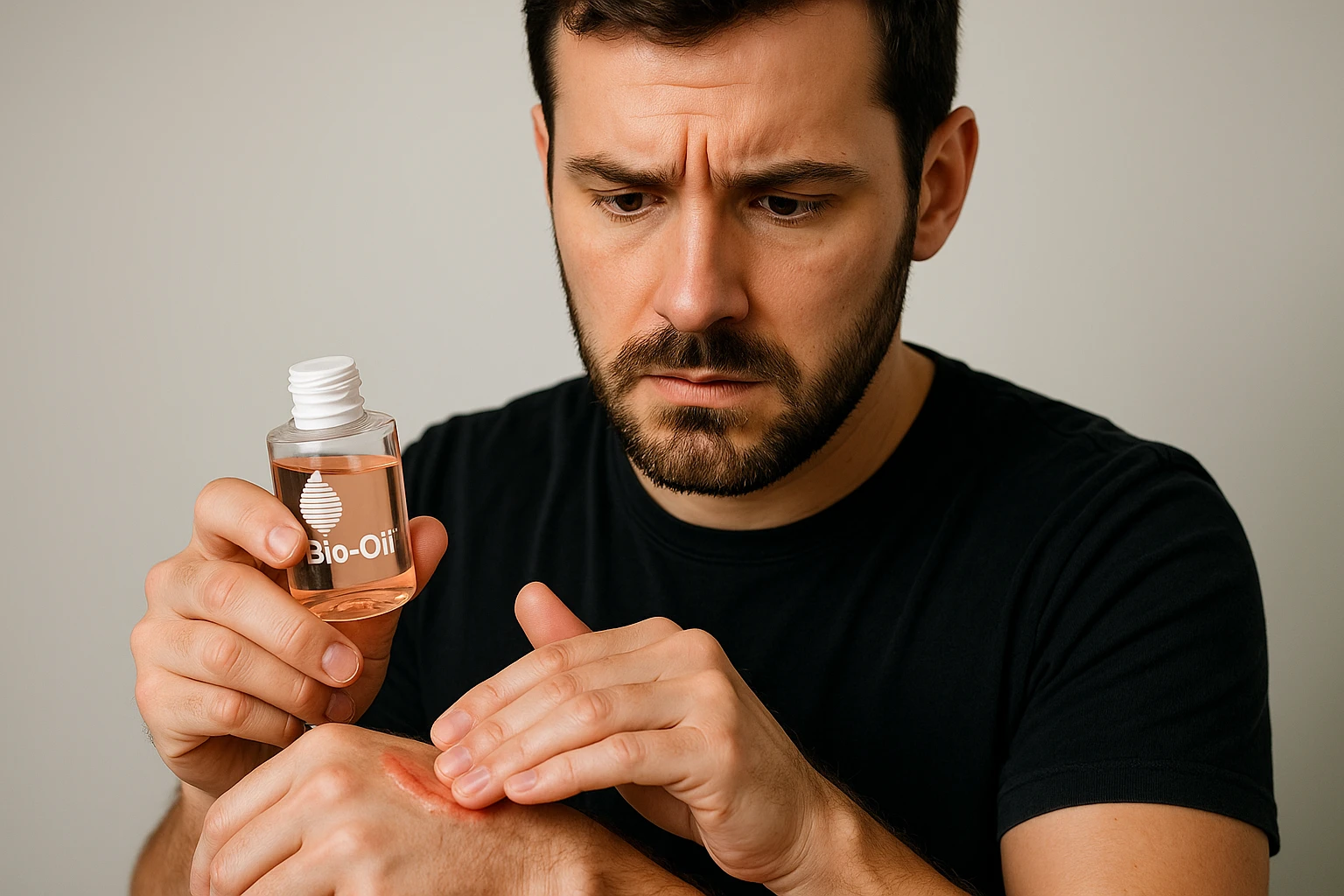
Section 9: Understanding the Limitations and Appropriate Expectations
Even with diligent use, it's critical to understand what realistic expectations one can hold when incorporating Bio Oil for keloids into a skincare regimen. At its core, this product offers effective hydration and softening benefits—qualities that may make surface-level improvements in texture or tone. For example, testimonials shared on forums suggest that prolonged massage with Bio‑Oil softened the keloid’s texture and reduced redness over months of consistent use, though without noticeably reducing the size or height of the scar keloidstreatment.com.
Importantly, clinical guidance emphasises that keloids arise from deeper structural changes—excess collagen proliferation—that topical moisturisation alone cannot reverse. A recent analysis notes that while vitamin E and plant oils in such cosmetic blends are great for surface hydration, they lack the potent anti-fibrotic actives needed to remodel fibrous tissue in true keloids keloidstreatment.com.
Parallel lines of evidence affirm that first-line treatments for keloids centre on medical-grade interventions such as silicone gel sheeting or corticosteroid injections. Silicone sheeting, in particular, is backed by systematic reviews and clinical trials as a gold-standard, non-invasive option that flattens raised scars via semi‑occlusive hydration and mechanical modulation of collagen dynamics self.com.
Yet, there is some emerging research into alternative oil-based approaches. For instance, in vitro studies on omega‑3‑rich oils—such as fish oil or traditional remedies like boa constrictor oil—showed superior inhibition of keloid fibroblast proliferation compared to corticosteroids under laboratory conditions pubmed.ncbi.nlm.nih.gov. While fascinating, these findings remain preliminary and far from demonstrating clinical effectiveness in humans.
In practice, combining surface moisturisers like Bio‑Oil with proven therapies may offer complementary benefits. Several users report applying silicone strips overnight and massaging with Bio‑Oil during the day to maintain hydration and suppleness, although managing oil residue to ensure adhesion remains a challenge reddit.com. This underscores the importance of thoughtful routines and patch testing.
Altogether, it’s vital for readers to hold balanced, informed expectations. While bio oil may deliver cosmetic improvements—such as softer texture or reduced discolouration—real structural change in keloid scar tissue typically requires evidence‑based treatments like silicone therapy or professional injections. Integrating moisturising rituals judiciously within a broader, dermatologist‑guided strategy offers the best path forward.
Section 10: Incorporating Bio Oil within a Comprehensive Keloid Care Regimen
Continuing from our discussion on setting realistic expectations, it’s essential to examine how incorporating bio oil for keloids may complement a holistic treatment strategy when used thoughtfully and in accordance with medical advice. While Bio‑Oil cannot fundamentally alter the collagen architecture of a keloid, it can play a supportive role by enhancing skin hydration and improving surface texture, as noted by users who reported smoother, softer keloid surfaces over time keloidstreatment.com.
Structured Routine Integration
A valuable approach is to combine Bio‑Oil with evidence-based therapies such as silicone gel sheeting. For instance, patients may apply Bio‑Oil lightly after gently massaging the keloid to maintain moisturisation, followed by wearing a silicone sheet overnight to promote occlusion — a dual-action method that merges hydration with mechanical suppression of scar elevation en.wikipedia.org. Real-world accounts on skincare forums confirm that combining oil-based moisturisers with silicone sheets can enhance comfort and make long-term management more tolerable reddit.com.
Monitoring and Adjusting Based on Response
Not everyone responds positively to topical oils; anecdotal evidence shows some users experienced irritation, greasiness, or even no noticeable change in keloid characteristics acibademhealthpoint.com. It’s prudent to monitor any changes — such as redness, itching, or texture shifts — and adjust usage accordingly. For example, if Bio‑Oil causes discomfort or breaks the skin’s barrier, reducing application frequency or discontinuing use and consulting a dermatologist becomes necessary.
Case Study Insight
Consider a hypothetical scenario: a patient with a long-standing chest keloid initiates a regimen of gentle twice‑daily Bio‑Oil application paired with nightly silicone sheeting. After three months, they might observe slight softening and reduced shininess of the keloid's surface, though the overall size remains unchanged. Whilst the tangible structural change is limited, the improved skin feel might enhance adherence to long-term treatment — a critical foundation for success in keloid management.
Ultimately, integrating bio oil for keloids should be viewed as part of a supportive toolkit rather than a standalone solution. When deployed thoughtfully — combining hydration, occlusion, and professional interventions — it can enhance comfort and aesthetic appearance, bolstering both patient well‑being and commitment to comprehensive, evidence‑based care.
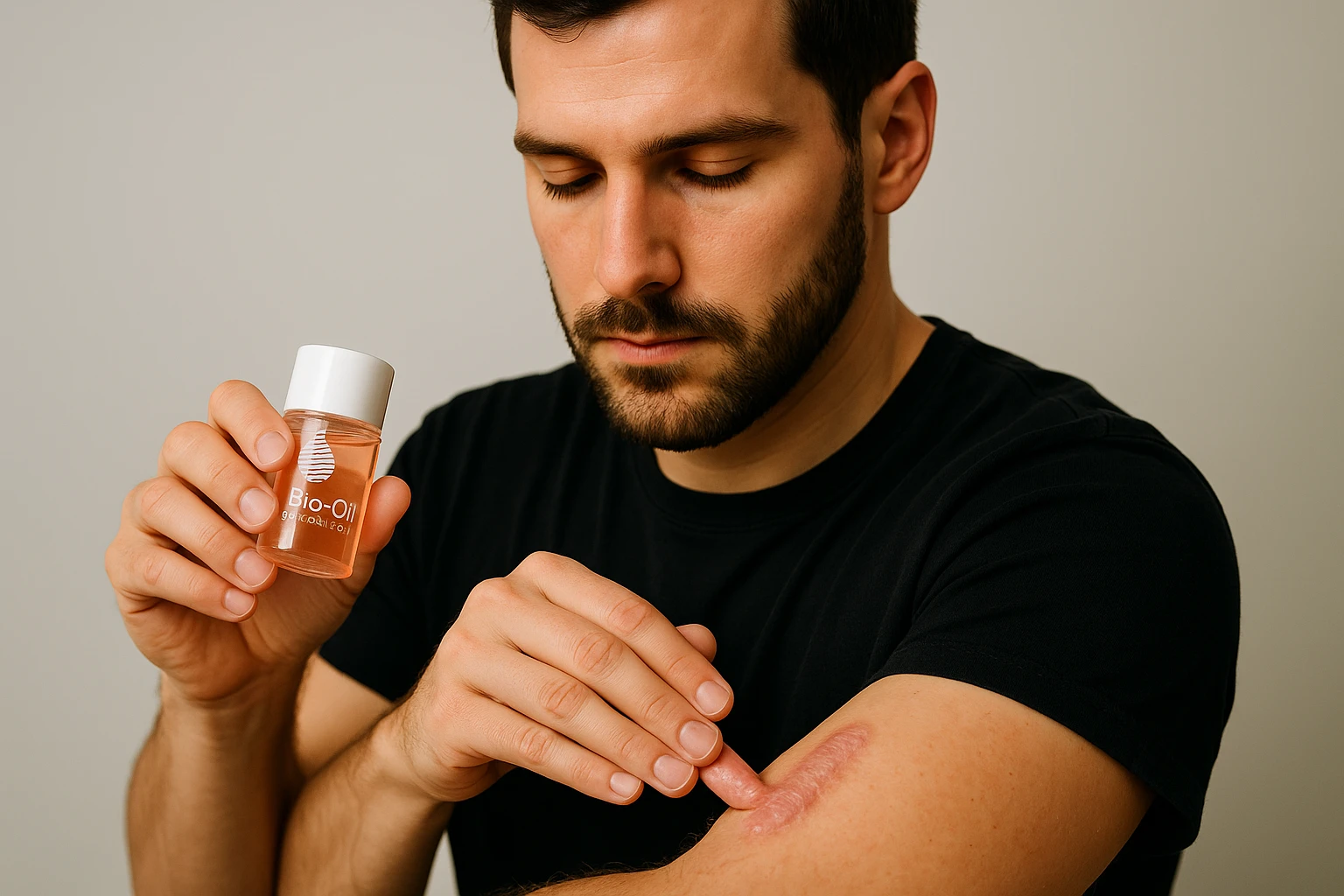
11. Complementary Approaches and When to Seek Professional Advice
While many users appreciate the moisturising and softening effects of Bio‑Oil, especially on newer or milder scars, established keloids often require more targeted medical interventions. For instance, silicone gel sheeting is widely accepted as the first-line non-invasive therapy, with clinical studies documenting its effectiveness in reducing both the thickness and prominence of keloid and hypertrophic scars en.wikipedia.org.
Combining Topical Oils with Evidence-Based Treatments
Supplementing routine scar care with oils such as rosehip or vitamin E may support skin health, yet these remedies rarely address the underlying collagen overproduction characteristic of keloids womenhealthdomain.com. In contrast, oils rich in omega‑3 fatty acids have demonstrated promising inhibitory effects on keloid fibroblast growth in vitro. Specifically, studies comparing fish oil and triamcinolone in cell cultures found that omega‑3 oils more effectively reduced fibroblast proliferation, and warrant further investigation as a potentially affordable adjunctive treatment pmc.ncbi.nlm.nih.gov.
Recognising When to Consult a Dermatologist
It’s sensible to seek professional guidance if you notice that your keloid persists, itches, causes discomfort, or stings despite regular care. Dermatologists can recommend evidence-based interventions such as corticosteroid injections, laser therapy, or silicone modalities tailored to your scar’s size, location, and individual skin response en.wikipedia.org. For example, combining massage with silicone tape has been reported by patients to significantly improve scar appearance when consistently applied over months reddit.com.
Making Informed Decisions for Better Outcomes
- Use soothing topical products like Bio‑Oil or rosehip oil to maintain skin hydration and texture, while understanding their limitations in treating mature keloids.
- Incorporate well-researched treatments such as silicone sheeting or dermatologist-prescribed steroids for deeper intervention.
- Monitor your progress diligently: if no improvement is observed after several weeks or if discomfort increases, consult a skin specialist promptly.
Ultimately, while moisturising oils play a supportive role, they should not replace clinically proven therapies. Recognising the strengths and limitations of each option empowers you to build a balanced, effective strategy for managing keloid scars.
12. Conclusion and Key Takeaways
As we draw this comprehensive exploration to a close, it’s clear that managing keloid scars requires a thoughtful, multi-layered strategy rather than reliance on a single solution. While moisturising oils can play a supportive role, the evidence underscores that they often fall short in addressing the deeper fibrotic architecture of keloids—though they may soften the surface or alleviate pigmentation to some extent, such improvements are generally modest and temporary KeloidsTreatment.com review.
Core Insights and Practical Takeaways
Rather than considering bio oil for keloids as a standalone remedy, view it as a gentle adjunct that may enhance skin hydration or marginally reduce redness in some individuals—such effects, however, are superficial and not consistently observed KeloidsTreatment.com. In contrast, silicone gel sheeting remains the clinical first-line for non-invasive therapy: over months of consistent use, it has been shown to significantly reduce scar thickness, colour, and texture through mechanisms like hydration, collagenase activation, and epidermal‑dermal signalling Silicone Gel Sheeting overview.
Case Illustrations and Real‑World Applications
- A patient on r/TopSurgery shared that massage combined with bio‑oil helped soften their keloid over two years, though medical professionals note such anecdotal benefits underscore the oil’s supportive, not curative, role Reddit case.
- In contrast, clinical studies affirm silicone gel’s efficacy: large-scale evidence supports its ability to improve scar metrics significantly, marking it as a more reliable option.
Ultimately, a robust keloid management plan should incorporate evidence‑based treatments—such as silicone therapy, corticosteroid injections, lasers, or radiation—tailored to individual scar characteristics and response patterns. Oils and massage can play a complementary role by improving comfort, skin condition, and patient morale during long treatment regimens.
Actionable Steps for Readers
- Begin with a consultation from a qualified dermatologist or plastic surgeon to evaluate your keloid and discuss first‑line, clinically proven options.
- Use silicone gel sheeting as a foundational non‑invasive therapy, committing to consistent, months‑long application to achieve meaningful results.
- Integrate moisturising oils as adjuncts for hydration, massage, or cosmetic comfort—but monitor response and avoid expecting structural improvement.
- Track progress with photographs, pain or itch scales, and SCAR‑Q scores where available to assess symptomatic and psychosocial improvements over time SCAR‑Q study.
In sum, remember that while using moisturising oils can feel soothing and supportive, they are not a substitute for proven therapeutic interventions. Establish a balanced, informed plan that combines the best of clinical evidence with nurtured skin care—this empowers you to manage your keloid with confidence, patience, and clarity.
Recommendations:
Share
YOU MAY ALSO LIKE
- Dec 24, 2025
- Dec 21, 2025
- Dec 19, 2025
- Dec 17, 2025
- Dec 16, 2025
- Dec 15, 2025
- Dec 15, 2025
- Dec 15, 2025
- Dec 11, 2025
- Dec 11, 2025
- Dec 08, 2025
- Dec 05, 2025
- Dec 05, 2025
- Dec 02, 2025
- Dec 01, 2025
- Dec 01, 2025
- Nov 30, 2025
- Nov 30, 2025
- Nov 29, 2025
- Nov 25, 2025
- Nov 24, 2025
- Nov 23, 2025
- Nov 22, 2025
Category
Recent Posts
- Dec 24, 2025
- Dec 21, 2025
- Dec 19, 2025
- Dec 17, 2025



















































